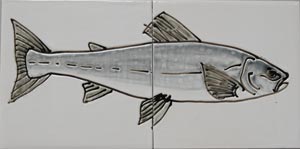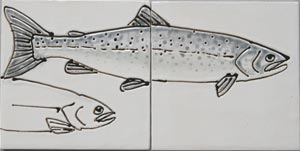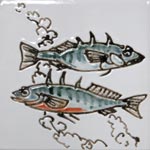Below are details of local fish, illustrated by the tiles by Bronwyn Williams-Ellis that decorate our campsite facilities. Many thanks to Rhodri Thomas for detail about these.

Salmon
Salmon [Eog mor iwerig](Salmo salar): Local Atlantic Salmon are born and spend the first 1-4 years of their life in freshwater before migrating out to sea for a further 1-4 years, mainly off the west coast of Greenland. They then return to the river of their birth to spawn, guided probably by the distinctive chemical “scent” of that river. They used to be abundant in the small streams leading into the Glaslyn River around the campsite. The first laws protecting salmon were issued by Edward I over 700 years ago.

Sewin
Sewin [Sewen](Salmo trutta trutta),or Sea Trout, are a migratory form of the resident Brown Trout which, like Salmon, have developed the habit of heading out to sea as young adults and returning to rivers to spawn. The majority of Welsh Sewin are female, and will interbreed with Brown Trout. The silver-coloured Sewin is highly prized by anglers and traditionally fished for by night. It is claimed that the Sewin was the last of the fish created by God, producing perfection through practice! There are currently concerns that Sewin may be declining in Wales.

Arctic charr
Arctic charr [Torgoch yr arctig](Salvelinus alpinus):This is one of the rarest fish in Britain, as it is found only in deep, cold glacial lakes- indeed it is the most northerly-occuring freshwater fish in the world. It is in Llyn Padarn, at Llanberis and is at threat of extinction. These are ancient relatives of salmon and trout. There is, believe it or not, a serious scientific body called the International Society of Arctic Charr Fanatics dedicated to the study of this beautiful fish. The ISACF meet every two years in different countries where charr are common to discuss Arctic Charr research and conservation…and then to catch and eat them!

Brown trout
Brown trout [Brithyll](Salmo trutta fario): The brown trout is a freshwater fish that is in local rivers and lakes. Although not endangered, fish numbers locally are under stress. In early winter the female creates a hollow (or “redd”) in gravel on the riverbed with her tailfin, in which she lays up to 1,500 eggs. Trout require cool, unpolluted and well-oxygenated water. The British record for a wild rod-caught Brown Trout is 31 lb 12 oz, from Scotland in 2009.

Eel
Eel [Llysywen](Anguilla anguilla): Eels are quite extraordinary fish. They are thought to spawn in the Sargasso Sea south of Bermuda. The transparent larvae, just 1-5 cm long, drift some 6,000 km across the Atlantic on ocean currents to reach Britain and other parts of Europe. On entering freshwater they metamorphose into young eels and, after spending between 5-20 years in rivers such as you might see locally, they make the return migration to the Sargasso sea to breed and die. Eels are critically endangered- in the last 25 years their numbers are thought to have declined by around 95%.

Stickleback
The three-spined stickleback (Gasterosteus aculeatus) is a fish native to most inland coastal waters north of 30°N. It has long been a subject of scientific study for many reasons. It shows great morphological variation throughout its range, ideal for questions about evolution and population genetics. Most populations are anadromous (they live in seawater but breed in fresh or brackish water) and very tolerant of changes in salinity, a subject of interest to physiologists. Sticklebacks live only in the Northern Hemisphere and usually inhabit coastal waters or freshwater bodies. It can live in either fresh, brackish, or salt water. It prefers slow-flowing water with areas of emerging vegetation. It can be found in ditches, ponds, lakes, backwaters, quiet rivers, sheltered bays, marshes, and harbours.
